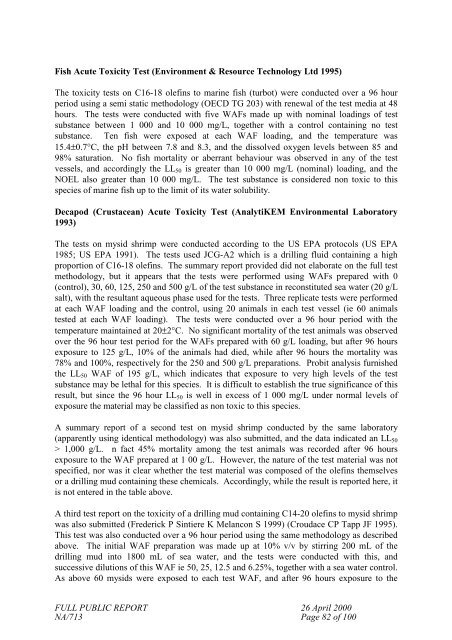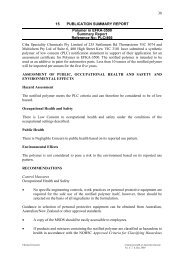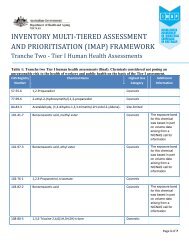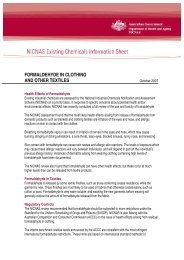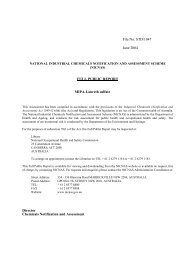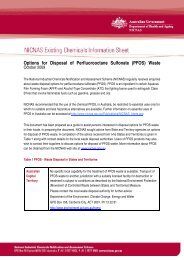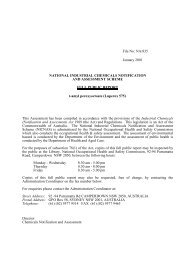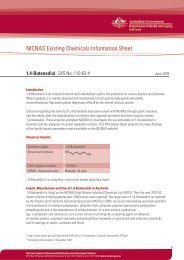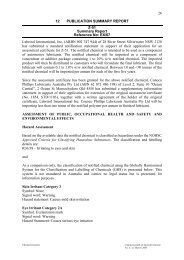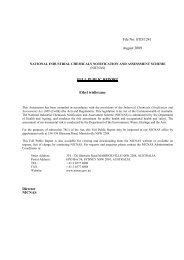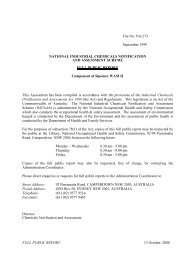GULFTENE C16-18 ISOMERISED OLEFINS - NICNAS
GULFTENE C16-18 ISOMERISED OLEFINS - NICNAS
GULFTENE C16-18 ISOMERISED OLEFINS - NICNAS
Create successful ePaper yourself
Turn your PDF publications into a flip-book with our unique Google optimized e-Paper software.
Fish Acute Toxicity Test (Environment & Resource Technology Ltd 1995)<br />
The toxicity tests on <strong>C16</strong>-<strong>18</strong> olefins to marine fish (turbot) were conducted over a 96 hour<br />
period using a semi static methodology (OECD TG 203) with renewal of the test media at 48<br />
hours. The tests were conducted with five WAFs made up with nominal loadings of test<br />
substance between 1 000 and 10 000 mg/L, together with a control containing no test<br />
substance. Ten fish were exposed at each WAF loading, and the temperature was<br />
15.4±0.7°C, the pH between 7.8 and 8.3, and the dissolved oxygen levels between 85 and<br />
98% saturation. No fish mortality or aberrant behaviour was observed in any of the test<br />
vessels, and accordingly the LL50 is greater than 10 000 mg/L (nominal) loading, and the<br />
NOEL also greater than 10 000 mg/L. The test substance is considered non toxic to this<br />
species of marine fish up to the limit of its water solubility.<br />
Decapod (Crustacean) Acute Toxicity Test (AnalytiKEM Environmental Laboratory<br />
1993)<br />
The tests on mysid shrimp were conducted according to the US EPA protocols (US EPA<br />
1985; US EPA 1991). The tests used JCG-A2 which is a drilling fluid containing a high<br />
proportion of <strong>C16</strong>-<strong>18</strong> olefins. The summary report provided did not elaborate on the full test<br />
methodology, but it appears that the tests were performed using WAFs prepared with 0<br />
(control), 30, 60, 125, 250 and 500 g/L of the test substance in reconstituted sea water (20 g/L<br />
salt), with the resultant aqueous phase used for the tests. Three replicate tests were performed<br />
at each WAF loading and the control, using 20 animals in each test vessel (ie 60 animals<br />
tested at each WAF loading). The tests were conducted over a 96 hour period with the<br />
temperature maintained at 20±2°C. No significant mortality of the test animals was observed<br />
over the 96 hour test period for the WAFs prepared with 60 g/L loading, but after 96 hours<br />
exposure to 125 g/L, 10% of the animals had died, while after 96 hours the mortality was<br />
78% and 100%, respectively for the 250 and 500 g/L preparations. Probit analysis furnished<br />
the LL50 WAF of 195 g/L, which indicates that exposure to very high levels of the test<br />
substance may be lethal for this species. It is difficult to establish the true significance of this<br />
result, but since the 96 hour LL50 is well in excess of 1 000 mg/L under normal levels of<br />
exposure the material may be classified as non toxic to this species.<br />
A summary report of a second test on mysid shrimp conducted by the same laboratory<br />
(apparently using identical methodology) was also submitted, and the data indicated an LL50<br />
> 1,000 g/L. n fact 45% mortality among the test animals was recorded after 96 hours<br />
exposure to the WAF prepared at 1 00 g/L. However, the nature of the test material was not<br />
specified, nor was it clear whether the test material was composed of the olefins themselves<br />
or a drilling mud containing these chemicals. Accordingly, while the result is reported here, it<br />
is not entered in the table above.<br />
A third test report on the toxicity of a drilling mud containing C14-20 olefins to mysid shrimp<br />
was also submitted (Frederick P Sintiere K Melancon S 1999) (Croudace CP Tapp JF 1995).<br />
This test was also conducted over a 96 hour period using the same methodology as described<br />
above. The initial WAF preparation was made up at 10% v/v by stirring 200 mL of the<br />
drilling mud into <strong>18</strong>00 mL of sea water, and the tests were conducted with this, and<br />
successive dilutions of this WAF ie 50, 25, 12.5 and 6.25%, together with a sea water control.<br />
As above 60 mysids were exposed to each test WAF, and after 96 hours exposure to the<br />
FULL PUBLIC REPORT 26 April 2000<br />
NA/713 Page 82 of 100


